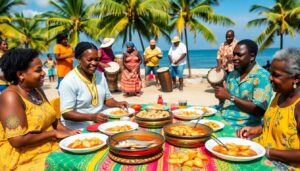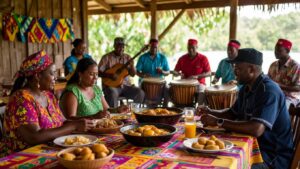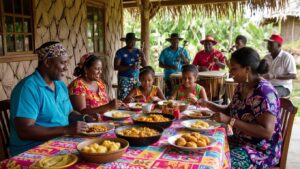Unveiling the Vibrant Garifuna Culture in Belize: A Journey Through Heritage, Culinary Wonders, and Unique Experiences
The Garifuna community in Belize epitomizes a rich cultural blend of African, Indigenous Caribbean, and European influences, crafting a heritage that is both distinctive and globally recognized, particularly by UNESCO. Their traditions are a colorful tapestry woven with elements such as language, music, culinary arts, dance, spiritual beliefs, and a profound sense of community. This comprehensive guide invites you to explore the intriguing history of the Garifuna people in Belize, shedding light on their traditions, festivals, delectable cuisine, and the vibrant cultural hub of Hopkins Village.
Exploring the Depths of Garifuna Heritage
The Garifuna are among the most celebrated cultural groups in Belize, with their lineage tracing back to the West and Central African ancestors, as well as the Indigenous Caribs and Arawaks. After resisting colonial domination in St. Vincent in 1797, they faced exile to Central America. Currently, the Garifuna community in Belize comprises approximately 30,000 individuals, who significantly enrich the cultural fabric of southern Belize through their unique language, exquisite cuisine, vibrant artistic expressions, and rich customs. UNESCO’s designation of their culture as a Masterpiece of the Oral and Intangible Heritage of Humanity underscores their enduring spirit and creativity. This cultural legacy continues to thrive in communities such as Dangriga, Hopkins, Seine Bight, and Punta Gorda, alongside diaspora populations across the Americas. Annually, the celebration of Garifuna Settlement Day on November 19 serves as a powerful reminder of their resilience, community spirit, and rich cultural heritage.

Diving into the Historical Roots of the Garifuna Community
Tracing the Rich Ancestry of African and Carib Lineages
The story of the Garifuna people originates in the 17th century, marked by the extraordinary union of African survivors from two Spanish slave ships and the Indigenous Carib and Arawak populations of St. Vincent in the Lesser Antilles. Over more than 150 years, intermarriage and cultural exchanges created a unique Afro-Indigenous identity known as the Garinagu. This identity is characterized by a vibrant blend of traditions, languages, and cultural practices that reflect their diverse ancestral heritage.
Forced Migration and New Beginnings in Belize
In 1797, after fierce resistance against British colonial forces, around 5,000 Garifuna were forcibly exiled from St. Vincent to Roatán, Honduras. This marked the onset of a migration wave along the Central American coastline. By the early 19th century, dynamic Garifuna communities had taken root in southern Belize, especially in culturally rich locales like Dangriga, often referred to as the cultural capital, as well as Hopkins, Seine Bight, and Barranco. British authorities supported these migrations, recognizing the value of skilled laborers adept in fishing and agriculture, which greatly contributed to the vibrancy of these communities.
Enduring Resilience and Cultural Preservation
Despite the numerous adversities brought about by European colonization, land dispossession, and systemic discrimination, the Garifuna have successfully maintained their language, social structures, and rich religious traditions. Established in 1981, the National Garifuna Council has been instrumental in advocating for cultural rights and education, ensuring that Garifuna heritage continues to thrive and be celebrated.
The Role of Language and Identity in Garifuna Culture
The Distinctiveness of the Garifuna Language
The Garifuna language is an Arawakan tongue distinguished by its integration of Carib and African loanwords, serving as a remarkable example in the realm of Central American languages. It features gendered pronouns, a complex tense system, and a rich array of oral traditions that encapsulate the community’s history and cultural values. However, the Garifuna language faces threats due to language shift attributed to urbanization and migration, with fewer than 15,000 Belizean Garifuna individuals remaining fully fluent in their native tongue.
Initiatives for Revitalization and Preservation of the Garifuna Language
The recognition of the Garifuna language and music as an Intangible Heritage by UNESCO in 2001 has sparked revitalization efforts within the community. In places like Hopkins and Dangriga, primary schools have begun implementing educational programs in Garifuna, while community radio stations disseminate music and news in the language, contributing to its preservation. Organizations such as GAMAE International have initiated language immersion summer camps aimed at reconnecting the youth with their ancestral roots and linguistic heritage.
Cultural Expressions of Identity and Global Diaspora Connections
The Garifuna identity is reinforced through traditional attire, ancestral lineage, clan symbols, and unique naming conventions. This identity is actively nurtured by cultural associations both within Belize and in diaspora communities situated in major cities such as New York, Los Angeles, and London, where they continue to celebrate and honor their rich heritage.
The Dynamic Realm of Garifuna Music and Dance
Intricate Rhythms and Spiritual Connections in Garifuna Music
Garifuna music is renowned for its intricate rhythmic patterns, seamlessly blending traditional African polyrhythms with indigenous chants. Drums, notably the primero (tenor) and segunda (bass), hold a central place in many spiritual rituals and celebrations. The sacred dugú ceremony, for example, features drum circles and ancestral invocations that aim to heal or bless families, showcasing the profound relationship between music and spirituality in Garifuna culture.
The Vibrant Dance Forms of Punta and Punta Rock
The punta dance is among the most cherished expressions of Garifuna culture, boasting rapid hip movements and complex footwork, often accompanied by call-and-response singing and lively percussion. Its contemporary evolution, known as punta rock, has gained popularity through renowned artists like Andy Palacio and Pen Cayetano, who merge traditional rhythms with modern instrumentation, helping to spread Garifuna culture to audiences worldwide.
Festivals and Community Celebrations: A Living Heritage
In the lively towns of Hopkins and Dangriga, dance troupes regularly perform during cultural festivals and for visiting tourists, forging a living connection between generations. These performances not only celebrate Garifuna heritage but also serve as a significant economic resource for the community, fostering tourism and cultural exchange.

Investigating Garifuna Cultural Practices and Spiritual Traditions
The Importance of the Dugú Ceremony in Garifuna Spirituality
The dugú ceremony is a significant multi-day event where extended families gather to honor the spirits of their ancestors, referred to as gubida. Led by a spiritual healer, or buyei, this ceremony encompasses music, dance, and communal feasting, with the aim of restoring harmony within families and the wider community. It underscores a deep respect for the land, ancestral heritage, and the collective responsibilities shared among community members.
Daily Life Interwoven with Spiritual Beliefs of the Garifuna
The spiritual beliefs of the Garifuna reflect a unique blend of Catholicism along with African and Arawak cosmologies. Their daily life includes various rituals such as blessing new structures, rites of passage for births and deaths, and agricultural celebrations. Important symbols, including the conch shell, sea turtle, and cassava, serve as vital connections between households, nature, and the ancestral spirits.
Delving into the Culinary Wonders of Garifuna Gastronomy
Essential Ingredients and Signature Culinary Creations
The culinary landscape of Garifuna culture is deeply rooted in staples like cassava (or yuca), plantains, coconut, and fresh seafood. Among their traditional offerings, ereba stands out as a cassava bread made from grated cassava that is pressed and toasted over an open flame. Another hallmark dish, hudut, features fish simmered in creamy coconut milk, served alongside mashed green and ripe plantains. Machuca, a hearty fish soup paired with garlicky, mashed plantain dumplings, and tapou, a savory coconut milk seafood stew, are also beloved. In the bustling street markets of Hopkins and Dangriga, visitors can indulge in local delights like cassava pone (a sweet cake), fried plantain balls (known as ganún), and refreshing conch ceviche.
Promoting Sustainable Culinary Practices in Garifuna Communities
Traditional Garifuna practices, such as seasonal fishing, shellfish gathering, and small-scale gardening, play a crucial role in promoting ecological stewardship. These practices are guided by cultural taboos and communal resource management principles. Culinary festivals held in Hopkins feature cooking competitions and food tours led by women’s cooperatives, ensuring the preservation of traditional recipes and culinary techniques, while also engaging visitors in the rich gastronomic heritage of the Garifuna community.
Hopkins Village: A Cultural Beacon of Garifuna Life
Historical Significance and Cultural Relevance of Hopkins
Established in the early 1800s and known as Yarumein in the Garifuna language, Hopkins is nestled along the stunning Stann Creek coast. It serves as a central hub for the Garifuna language, music, and crafts, embodying the rich cultural legacy of their community.
Essential Experiences to Explore in Hopkins Village
- Drum Circles: Join daily drum schools and enjoy nightly drum circles at local cultural centers for an immersive experience.
- Garifuna Museum: Discover artifacts, oral histories, and photographic archives that provide insights into migration, language, and music.
- Homestays and Workshops: Interact with local families who offer cooking lessons, fishing trips, and demonstrations of cassava bread preparation.
Annual cultural events in Hopkins, particularly the youth pageants during Garifuna Settlement Day, position the village as an authentic gateway to experiencing the rich cultural tapestry of Garifuna Belize.
Economic Impact of Cultural Tourism in Hopkins
Cultural tourism is a vital economic driver in Hopkins, supporting over 75% of local households through guest accommodations, handicrafts, music classes, and guided tours. The headquarters of the National Garifuna Council coordinates regional festivals and advocacy efforts, ensuring the ongoing vibrancy and visibility of Garifuna culture on a global stage.
Celebrating Garifuna Settlement Day: A Commemoration of Cultural Heritage
Historical Importance of Settlement Day Celebrations
Each year on November 19, since its inception in 1941 and national recognition in 1977, Garifuna Settlement Day commemorates the monumental arrival of Garifuna ancestors to Belize by canoe in 1802. The reenactment procession, known as Yurumein, brings villagers ashore carrying drums, cassava, and crops, accompanied by joyous singing and prayer, symbolizing their enduring legacy and cultural pride.
Modern-Day Festivities and Community Celebrations
The festivities of Garifuna Settlement Day harmoniously blend sacred and secular elements, featuring nightlong dugú ceremonies and all-day drumming in churches and community squares. Parades adorned in traditional attire, lively performances, and food fairs characterize the day. National broadcasts, media features, and diaspora celebrations in major US cities attract visitors from all over Belize and beyond, promoting awareness and appreciation for Garifuna cultural traditions.
Addressing Contemporary Challenges and Sustaining Cultural Heritage
Language Shift and Its Impact on the Youth
The phenomenon of language shift poses a significant threat to the Garifuna community, as many young individuals, especially in urban environments, increasingly communicate in English or Kriol at home. UNESCO has recognized this concerning trend, inspiring schools and NGOs to launch language immersion programs, radio broadcasts, and mentorship initiatives designed to preserve linguistic heritage and cultural identity.
Land Rights Issues and Tourism Development Pressures
The rapid growth of tourism and real estate development along coastal regions like Seine Bight and Hopkins threatens the traditional landholdings of the Garifuna people. Advocacy efforts led by the National Garifuna Council and collaborative NGOs focus on securing land rights, influencing urban planning, and ensuring that tourism revenues directly benefit local families and communities.
Engaging the Youth Through Art, Technology, and Diaspora Connections
Garifuna artists and musicians, both locally and within the diaspora, are actively documenting music, recipes, and oral histories to create digital archives and virtual festivals. These modern platforms are essential in fostering connections between the broader Garifuna community and younger generations, ensuring that their rich cultural heritage is preserved and celebrated across future generations.
Guidelines for Engaging with Garifuna Culture Responsibly
- Select accommodations in Hopkins, Dangriga, or Seine Bight, and book tours directly with Garifuna-owned businesses to contribute to the local economy.
- Take part in a drum workshop, attend a Settlement Day celebration, or volunteer in local cultural preservation projects to fully immerse yourself in the culture.
- Support women’s cooperatives by sampling traditional dishes or purchasing handmade items to promote sustainable livelihoods.
- Always respect local customs; obtain permission before photographing individuals and be considerate during rituals and ceremonies.
- Learn a few basic phrases in the Garifuna language to express your respect and genuine interest in the culture.
The Garifuna culture in Belize is a vibrant blend of resilience, deep spirituality, captivating music, exquisite culinary offerings, and strong community bonds. By visiting places such as Hopkins or Dangriga, participating in local festivals, or engaging with the rhythmic sounds of the drums, travelers are granted a unique opportunity to connect with a rich historical continuum where the past and present resonate harmoniously. Supporting Garifuna-owned businesses, honoring their traditions, and celebrating the linguistic and culinary diversity of this remarkable culture are essential actions for ensuring its survival and flourishing for future generations.
References and Further Reading on Garifuna Culture
- Language, Dance and Music of the Garifuna – UNESCO Intangible Heritage
- History Of The Garifuna People – Belize.com
- Garifuna people – Wikipedia
- Varner, G.R. “Native Status and Maya Identity in Belize.” Journal of Latin American Anthropology, 1998
- Lee, N.R. “Toledo Garifuna and Indigenous Rights.” Mesoamerican Research, 2022
- National Garifuna Council – Wikipedia
- The Garifuna Living Heritage – ICH NGO Forum, 2023
- Dinther, R. “Language Shift and Prestige: Garifuna in Hopkins.” Journal of Pidgin and Creole Languages, 2017
- Habinaha Garifuna Language Program
- Veal, T. “Africanisms in Garifuna Culture of Belize.” Cultural Anthropology, 2004
- National Geographic: Preserving Garifuna Identity Through Ritual
- Music In Africa: Punta Rock and Garifuna Music
- Hopkins Cultural Center Official Site
- Cultural Survival Quarterly: Maya Rainforest and Garifuna in Belize
- Belize Living Heritage: Rituals and Social Practices
- Texas A&M: Belizean Food Culture
- Love Your Belize: Hudut Recipe
- Global M&A Pages: Sustainable Fishing Cooperatives
- National Garifuna Council of Belize
- UN Sustainable Development Reports on Garifuna Cultural Tourism
- Ambergris Caye: Garifuna Settlement Day Celebrations
- Garifuna.com: Diaspora, Digital Storytelling, and Modern Initiatives
The Article Garifuna Culture in Belize: Heritage, Food & Where to Experience It appeared first on Belize Travel Guide
The Article Garifuna Culture: Experience Heritage and Cuisine in Belize Was Found On https://limitsofstrategy.com





No responses yet